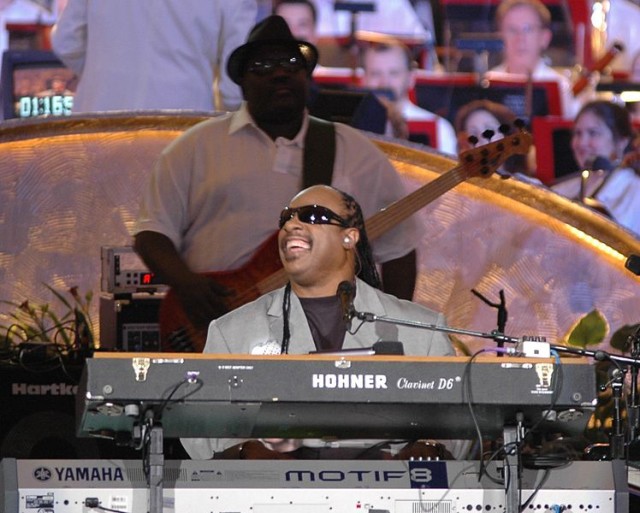
“For a while now, I’ve been thinking about making an album called Songs in the Key of Peace.” With this proclamation, Stevie Wonder received thunderous applause from the nearly 20,000 fans that filled the sold out Oracle Arena in Oakland, California. Stevie Wonder is on tour, showcasing his revered 1976 album, Songs in the Key of Life, in 12 cities across the United States.
Nearly forty years since the album dropped, the Presidential Medal of Freedom winner is still addressing the themes of love and peace for which he became a living icon. Before playing a note, Wonder set an optimistic tone for the night - rather than bombarding the audience with sunshine and flowers, his unabashed smile and care free attitude helped battle concurrent unrest pervading out of Staten Island, and the shadow of Ferguson that still clung to the audience. For the next three hours, 24-hour media coverage was off, and Stevie Wonder was on.
At his center stage grand piano, Wonder launched directly into “Love’s in Need of Love Today,” the lead song of the album. The first act wove in and out of classics, from feet-movers like the giddy “Sir Duke,” to the mental Waltz of “Village Ghetto Land,” showcasing the largely undated trials of Wonder’s hometown Detroit. Tour-mate India.Arie performed alongside her self-proclaimed idol, showcasing her vocal abilities and lyrical prowess in gown after flowing gown. In a surprise appearance, the band was joined by Sheila E., renowned drummer, percussionist, singer, and of most import to the East Bay crowd, Oakland native.
“The thing about all musicians is, we all love to jam.”
With that, Wonder referenced his exceptional string orchestra, a collective of native Oakland musicians, with whom he performed a rhythmic call and response. The responses increased in difficulty, and eventually into a syncopated, surprisingly R&B measure that hit the two and four in head-rocking ways. Respect for the musicality transformed into elation at unexpected funk, and the audience erupted to their feet. Wonder had provided the catalyst, and subsequently the proof - everybody loves to jam.
Call and response continued throughout the night, opening up a tremendous musical exchange amongst the various artists on stage and the audience. In an inspiring talent show, Wonder entered into one such call and response with Keith John, a backup singer, pushing his voice to shockingly high pitches. John held his own during the row, until Wonder’s final go included bars of sheer laughter, and then an unsubdued launch into incomparable falsetto and vibrato. Laughing along with Wonder and the entire stadium, John humbly conceded. This exchange cemented a fact that the audience dearly hoped was still true: not only were the 64-year-old Wonder’s pipes more than intact, they were still undoubtedly, the best.
The night continued with more Wonder benchmarks, as the diverse crowd let “Another Star,” “As,” and “If it’s Magic” usher in nostalgic memories for all. The musical genius, the unrelenting fun, the roller coaster of challenging yet revitalizing themes that you imagine a Stevie Wonder show to be, were all there.
However, there was an added element, which was not quite as evident until the encore. The encore began as any encore does, with every artist crowding the stage to party as a big family. But it’s different when it really is family. It’s different when Stevie describes the making of “Isn’t She Lovely,” and the audience is introduced to a phenomenal backup singer, who happens to be the daughter for whom he wrote the song. It’s different when you realize that Stevie’s brother and son are both on stage, helping with the tour. It’s different when you realize that Stevie is still playing with Nate Watts, one of the most renowned bassists of the past half-century, who has been with Stevie for forty years.
When you see a big family inviting you in, you accept the embrace and open up to this character that may as well be your uncle for the night. Your, arguably-most-influential-artist-of -the-last-fifty-years, still-selling-out-stadiums, uncle.
So when your Uncle Stevie launches into an alter ego by the name of D.J. Tick-Tick-Boom to emcee the encore, you laugh and you listen, accepting the phenomenal antics. When D.J. Tick-Tick-Boom invites comedian Dave Chappelle to come party on stage for the encore, you laugh even harder, because, wow, there’s Dave Chappelle, being as ridiculous as ever.
But most importantly, when D.J. Tick-Tick-Boom stalls the fun for a moment, re-assumes his true personality as the venerable Stevie Wonder, and begins playing the chords to the relentlessly powerful anthem of social justice, “Living for the City,” your ears are all his.
“I’m tired of playing this song… but there’s still all this bullshit going on!”
When the audience grasped that this champion for peace and freedom was playing “Living for the City” for the same reason that he played it in 1974, the undertones on the state of the world became overtones, and focus could not be anywhere else. Themes of justice permeated the stadium, yet they did not crowd. Listeners were inspired to think, appreciate, and question next moves, providing necessary invigoration that a greater place to live must be a collective effort.
Yet when all was said and done, Wonder’s music allowed for whatever moment the listener desired. Pounding out “Don’t You Worry About a Thing,” “My Cherie Amour,” and “Superstition” to cap off the night, Stevie Wonder took many people back to cherished memories, while some listeners could not be more content than they were in that present moment. And for others, the music that cascaded over the crowd that night allowed for optimism of a future not only worth living in, but worth working towards.
***
Photo credit: John Athayde
